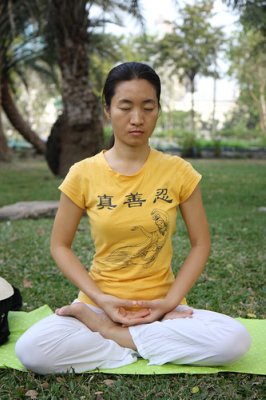Good Meditation Posture
The Do's & The Don'ts
The right meditation posture is important because it allows you:
- to open up your body for deep natural breathing
- to remain alert while you meditate
- to sit comfortably while you meditate
It is important that you listen to your body.
If you are uncomfortable you won’t be able to achieve the best results from your meditation session and instead of your mind being clear and quiet it will be telling you that something is wrong – that your body is in discomfort.
You should be free of all distractions and so proper meditation posture is
important.
The best meditation posture is one that allows you to sit in comfort and alertness.
You can choose to:
- sit on the floor with your legs crossed
- sit on a meditation chair with your feet flat on the floor
or
- sit or kneel on a meditation
pillow.
Meditation Posture Don'ts
Meditation calls for not only alertness in the mind but also in the body. So practicing good meditation posture is important.
- Attention must be paid to the spine to make sure it is aligned and that there is no slouching/slumping or overarching. Slouching/slumping – caused by sitting too low, insufficient tilt in your seat or bad habit of slouching. Overarching – caused by sitting too high, seat tilted too far up, bad habit of over arching
- Lying down is not advised. It is easy for you to fall asleep, rendering the meditation session useless.
- Your seat must be at the right height and slope to prevent slouching or a strained back.
Meditation Posture Do's
From Head to Toe

photo courtesy of longtrekhome
Head
- Your head should be balanced evenly – not tilted to the left or right
- Your face should be relaxed. Un-knit your eye brows, unclench your jaw
- Close your eyes – unless the type of meditation requires you to focus on an object
- Your chin should be slightly tucked in – not too far forward so that your head hangs forward and not too far back that your looking up
Neck
Your neck should be long but relaxed.
Shoulders
- Your shoulders should be relaxed - down and not up like they are attached to your ears.
- Your shoulders should be drawn back to open the chest in order for you to breathe freely.
Back
Your spine must be upright with a natural curve to it. You shouldn’t be slouching over or arching your back too much.
Hands
- Your hands should be resting comfortably on your lap or on a cushion, palms facing upwards or the left hand gently resting in the right hand, still with palms facing upwards and your thumbs touching.
- There should be no strain in your shoulders or between the shoulder-blades.
Legs & Feet
The position of your legs depend on your choice of sitting, which is also based on your comfort and flexibility level.
- You can sit with your legs crossed. Only sit in this position if you are flexible enough. You may cause serious damage to yourself if you force yourself in this position. Make the seating choice that is best for you.
- Sit cross-legged with both knees on the ground. If your knees are not touching the ground, place a towel or a thin cushion under your knees. With your toes pointing outward, rest one foot on the opposite thigh, rest the other foot (toes pointing out) on the floor (Half Lotus). For those of you, who are more flexible, then place your feet with toes pointing out, on opposite thighs (Full Lotus).
- If sitting on a meditation pillow or cushion , sit to the front of the pillow so your back remains straight. To sit with your feet on the floor you will need to add more cushions to adjust to the proper height.
- You can sit on a meditation chair. Your feet should be placed flat against the floor.
The right meditation posture is important so that you can achieve the most from
meditation session. It helps you to be relaxed, alert and aware of your body.
Related Articles
- Key Things You Must Know When Learning How to Meditate
- The 3 Main Benefits of Meditation
- Meditation Chairs - The right seating arrangement
- Meditation Pillows & Cushions - Making the right choice
- Meditation Techniques & Tips to Help Beginners Stay on Track
- The 2 Main Types of Meditation
- Types of Soothing Music for Meditation
Return from Meditation
Posture to Practicing Meditation
for Beginners
Return to Soothing Stress Relief Home